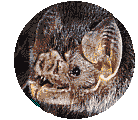
|
|
 Bats come in two distinct types. Megabats (megachiroptera) and Microbats (microchiroptera). They have very different characteristics. To see a sample of an outline that can be used to write a report comparing mega and microbats, click here.
Bats come in two distinct types. Megabats (megachiroptera) and Microbats (microchiroptera). They have very different characteristics. To see a sample of an outline that can be used to write a report comparing mega and microbats, click here.
-
Megabats
- Large in size.
- Very prominent eyes.
- Do not use echolocation. Use sight instead.
- Small ears compared to microbats.
- Commonly called fruit bats due to their diet.
-
Microbats
- Small in size compared to fruit bats.
- Unusual facial features.
- Small eyes.
- Large ears.
- Use echolocation.
Here are some pictures of different types of bats. Bats live on all continents except for antarctica. Bats are the largest group of mammals in the world and make up about 20% of all mammals (1 out of every 5). Megabats are important for pollination of night blooming plants. Microbats are important in keeping the insect population down. Many bats are endangered due to habitat destruction and ignorance about how important they are to the ecology. The only bat which causes any destruction that affects people is the vampire bat, which feeds on cattle in Mexico and South America. Bats come in all kinds of sizes from the bumble bee bat, which is often mistaken for a bee, and some megabats which can have a wingspan of up to five feet. While there are some mammals in the animal world that have wings, the bat is one of the only mammals that can actually fly. The membrane that is located between its body and fingers allows it to propel itself forward with a flapping motion.
This is how bats are classified:

Bats live in colonies and care for each other's young in bat nurseries. A mother bat can recognize her baby's cry from thousands of other bats.
Click on the picture to see a large picture | ||
 Hoduran White |
 Grey Heated Flying Fox | |
 Wahlberg's Epauleted Bat |
||
Click on the picture to see a large picture |  Chapin's Free-Tailed Bat |
 False Vampire Bat |
 Frog Eating Bat |
 Gothic Bat |
 Pallid Bat |
 Spotted Bat |
 Townsend's Big Eared Bat |
|
|
BCI is run by Dr. Merlin Tutle, the world's premier expert on bats.
Lots of facts and information for kids including a 24 hour live bat cam.
Takes several minutes to download at 56k.
Ages 3-10 bat activities online.
One man's attempt to create a perfect environment to attract bats. Tons of links to bat sites.
Basic facts about bats in general.
Research project in Australia concerning censusing Flying Foxes.
Nasa website with an illustrated bat story meant for kids.
Visit the bat cave.
Facts, anatomy, and echolocation.